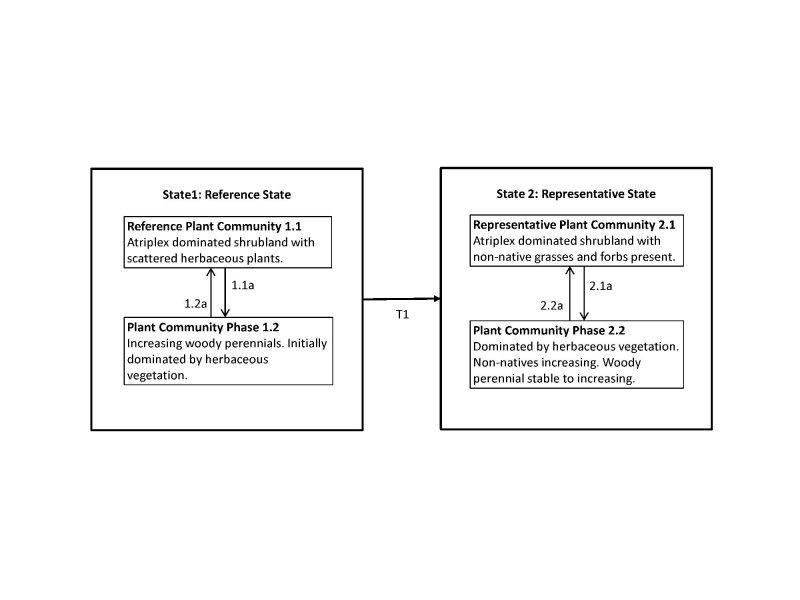
Natural Resources
Conservation Service
Ecological site R030XA022CA
Loamy 5-7
Last updated: 10/21/2024
Accessed: 01/10/2025
General information
Provisional. A provisional ecological site description has undergone quality control and quality assurance review. It contains a working state and transition model and enough information to identify the ecological site.
MLRA notes
Major Land Resource Area (MLRA): 030X–Mojave Basin and Range
The Mojave Desert Major Land Resource Area (MLRA 30) is found in southern California, southern Nevada, the extreme southwest corner of Utah and northwestern Arizona within the Basin and Range Province of the Intermontane Plateaus. The Mojave Desert is a transitional area between hot deserts and cold deserts where close proximity of these desert types exert enough influence on each other to distinguish these desert types from the hot and cold deserts beyond the Mojave. Kottek et. al 2006 defines hot deserts as areas where mean annual air temperatures are above 64 F (18 C) and cold deserts as areas where mean annual air temperatures are below 64 F (18 C). Steep elevation gradients within the Mojave create islands of low elevation hot desert areas surrounded by islands of high elevation cold desert areas.
The Mojave Desert receives less than 10 inches of mean annual precipitation. Mojave Desert low elevation areas are often hyper-arid while high elevation cold deserts are often semi-arid with the majority of the Mojave being an arid climate. Hyper-arid areas receive less than 4 inches of mean annual precipitation and semi-arid areas receive more than 8 inches of precipitation (Salem 1989). The western Mojave receives very little precipitation during the summer months while the eastern Mojave experiences some summer monsoonal activity.
In summary, the Mojave is a land of extremes. Elevation gradients contribute to extremely hot and dry summers and cold moist winters where temperature highs and lows can fluctuate greatly between day and night, from day to day and from winter to summer. Precipitation falls more consistently at higher elevations while lower elevations can experience long intervals without any precipitation. Lower elevations also experience a low frequency of precipitation events so that the majority of annual precipitation may come in only a couple precipitation events during the whole year. Hot desert areas influence cold desert areas by increasing the extreme highs and shortening the length of below freezing events. Cold desert areas influence hot desert areas by increasing the extreme lows and increasing the length of below freezing events. Average precipitation and temperature values contribute little understanding to the extremes which govern wildland plant communities across the Mojave.
Arid Western Mojave Land Resource Unit (XA)
LRU notes
The Mojave Desert is currently divided into 4 Land Resource Units (LRUs). This ecological site is within the arid portions of the Mojave where precipitation primarily occurs during the winter months (Hereford et. al 2004). The lack of summer precipitation as well as cooler temperatures allows cool season species to occupy sites at lower elevations than they do in the Eastern Mojave. For example, sandberg bluegrass, winterfat and spiny hopsage are common at lower elevations in the Western Mojave than they are in the Eastern Mojave. Warm season species like big galleta rarely occur in the Western Mojave. The Arid Western Mojave LRU is designated by the 'XA' symbol within the ecological site ID and is roughly equivalent to Western Mojave Basins and Western Mojave Low Ranges and Arid Footslopes of EPA Level IV Ecoregions.
Elevations range from 1650 to 4300 feet and precipitation is between 4 to 8 inches per year. The Arid Western Mojave LRU is distinguished from the Arid Eastern Mojave (XB) by the lack of summer precipitation which excludes many warm season plant species from occurring in this LRU. Vegetation includes creosote bush, rabbitbrush, shadscale saltbush, spiny hopsage, winterfat, Nevada jointfir, and Joshua tree. At the upper elevations of the LRU, plant production and diversity are greater and blackbrush is a common dominant shrub. The Arid Western Mojave LRU generally lacks the diversity of yucca, cacti and warm season species found in the Arid Eastern Mojave.
Ecological site concept
This ecological site is found on soils among fan skirts and fan aprons over a lake terrace within the Arid Western Mojave Land Resource Area. Alluvial and eolian processes cover the old lake terrace with fresh material making this a highly dynamic system. The soil particle size is loamy.
The central concept for this ecological site is within the Soil Survey of Edwards Air Force Base, California, Parts of Kern, Los Angeles, and San Bernardino Counties on the Helendale component in the 114 - Helendale loamy sand, 0 to 2 percent slopes map unit.
This is a grouped ecological site concept and STM linked to associated sites: R030XA050NV, R030XB141CA, R030XB142CA, R030XF013CA, R030XF024CA
Associated sites
| R030XA009CA |
Alkali Flat 5-7 Alkali Flat 5-7 |
|---|---|
| R030XA031CA |
Sodic Dunes 5-7" P.Z. Sodic Dune 5-7 |
Similar sites
| R030XA027CA |
Sandy 5-7" P.Z. Sandy 5-7 |
|---|---|
| R030XA031CA |
Sodic Dunes 5-7" P.Z. Sodic Dune 5-7 |
| R030XA030CA |
Shallow Loam 5-7 Shallow Loam 5-7 |
Table 1. Dominant plant species
| Tree |
Not specified |
|---|---|
| Shrub |
(1) Atriplex confertifolia |
| Herbaceous |
(1) Achnatherum hymenoides |
Click on box and path labels to scroll to the respective text.
